Keywords
|
| Photonic Crystal Fibers (PCFs), Total internal reflection (TIR), Effective Refractive index (neff), Chromatic Dispersion (CD),dielectric. |
INTRODUCTION
|
| Photonic crystals are periodically arrangement of dielectric media .Photonic crystals are typically made by taking a unit cell containing dielectric material of different index of refraction and repeating this unit cell to construct the crystal. Photonic-crystal fibre (PCF) is a new class of fibres which offers a great deal of freedom in their design to achieve lot of peculiar properties. Photonic crystal fibres (PCFs) are made from single material such as silica, with an array of air holes running along its length. A defect can be created by removing the central air hole with glass to guide light by total internal reflection (TIR) between the solid core and the cladding region. These index-guiding PCFs also are called holey fibre, holey assisted fibre. |
| These fibres possess an attractive feature of great controllability in chromatic dispersion, which is very much important in order to keep the dispersion as low as possible for wide range of wavelength. The above control can be achieved by varying the air hole diameter of defect core. |
| A full-vector TE mode is used to perform the modal analysis which generates the effective refractive index, which is further used to calculate the chromatic dispersion. Categories of PCF include photonic-band gap fiber (PCFs that confine light by band gap effects), holey fiber (PCFs using air holes in their cross-sections), hole-assisted fiber (PCFs guiding light by a conventional higher-index core modified by the presence of air holes), and Bragg fiber (photonicband gap fiber formed by concentric rings of multilayer film). Photonic crystal fibers may be considered a subgroup of a more general class of micro structured optical fibers, where light is guided by structural modifications, and not only by refractive index differences. |
| Photonic crystals are of different types: 1D (dimensional), 2D and 3D. |
| • where the variation is along one direction, we call it a 1D Photonic crystal. |
| • Similarly, we define 2D and 3D Photonic crystals corresponding to the respective cases where varies dielectric constant along two and three directions. |
| The design of PCFs is very flexible. There are various parameters to design the fiber: lattice pitch (Λ), air hole shape (circular or elliptical) and diameter (d), refractive index of the glass, and type of lattice (square, hexagonal). |
DISPERSION FORMULA
|
| Chromatic dispersion is the main contribute to the optical Pulse broadening. Combined effect of material and waveguide Dispersion cause chromatic dispersion. Here sellemier formula is used for calculating wavelength dependent refractive index. Where the index of air is assumed to be constant. The chromatic dispersion D is proportional to the second derivative of the neff, with respect to the wavelength (λ) obtained as |
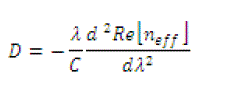 (1) (1) |
| Where λ is wavelength, Re [neff] is the real part of neff, , and c is the velocity of light in vacuum [5]. The chromatic dispersion is calculated as the sum of the geometrical dispersion (or waveguide dispersion) and the material dispersion obtained as: |
 (2) (2) |
GUIDANCE MECHANISMS IN PHOTONIC CRYSTAL FIBERS
|
| Possibly there can be two types of guiding mechanisms: The guided modes may be trapped in a core with a higher average index than the cladding region by an effect called as modified total internal reflection (index-guiding), or they can be trapped in a core of lower average index by a photonic band gap effect (PBG-guiding). |
PARAMETERS OF PCF
|
| In this type of PCF consists of a defect core with artificially-periodic cladding consisting of micrometer-sized air-holes The wafer chosen is silica with refractive index 1.45 and the refractive index of air holes is 1.The pitch (Λ) which is center to center spacing between two nearest air holes is kept as 2.0 μm. The air hole diameter is 1.5 μm. and defect core diameter (d’) is 0um, .2.0um, .4.0um, .6.0um as shown in figure 1. |
| Since the designed PCF consists of a solid core with a regular array of air holes running along the length of the fiber acting as the cladding. |
| • In this type of PCF the mean cladding refractive index is lower than the core index. |
| • The wafer chosen is silica with refractive index 1.45 and the refractive index of air holes is 1. |
| • The pitch (Λ) which is center to center spacing between two nearest air holes is kept as 2.0μm.The air hole diameter is 1.5 μm and defect core diameter(d’) is 0.0 um, 0.2um,0.4um,0.6um |
EFFECTIVE REFRACTIVE INDEX
|
| The Effective refractive index decreasing with defect-core increases.It is wavelength depended that decreasing with increasing wavelength.as shown in figure 2. |
SIMULATION RESULTS
|
| Here designed and found dispersion properties of defect core Photonic Crystal Layout with a hexagonal lattice of air holes and dielectric medium refractive index of SiO2 is 1.45. Electric field distribution is shown in figure 2. It should be flower like arrangement with all the fields being confined in the core region |
| The waveguide (geometrical) dispersion is cancel out with the material dispersions shown in fig.4. So we can design zero dispersion photonic crystal fibre as shown in fig.5 with different core diameters. |
CONCLUSIONS
|
| In conclusion, we consider five ring defect core photonic crystal fiber. Here defect core diameter is 0 um, 2.0 um, 4.0 um, 6.0 um .The chromatic dispersion decreases with increase in defect core diameter. It was shown from these results that flattened dispersion values 0.39031 ps/km/nm to 4.72915 ps/km/nm are achieved over a wavelength range 1.1 um to 1.7 um. |
Figures at a glance
|
 |
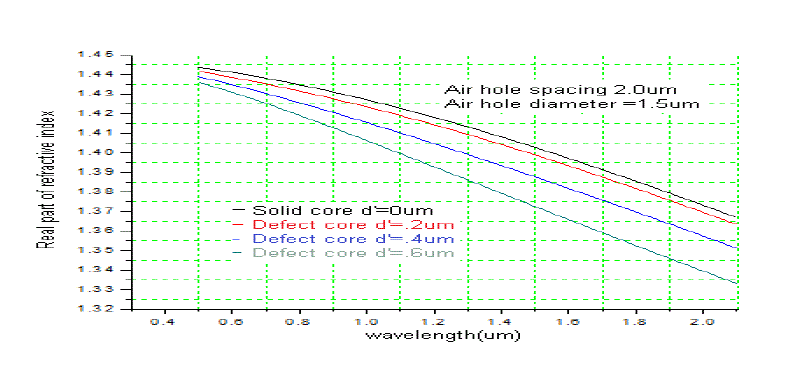 |
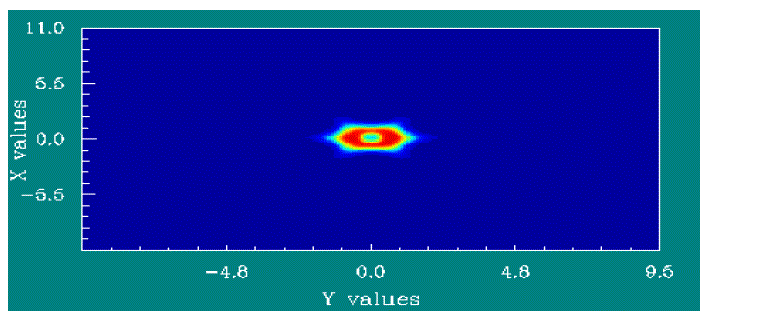 |
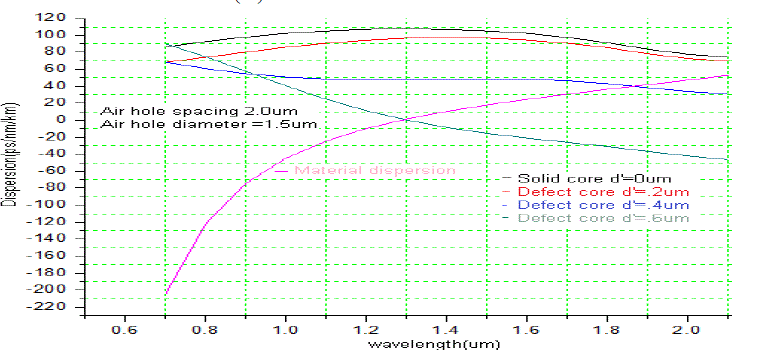 |
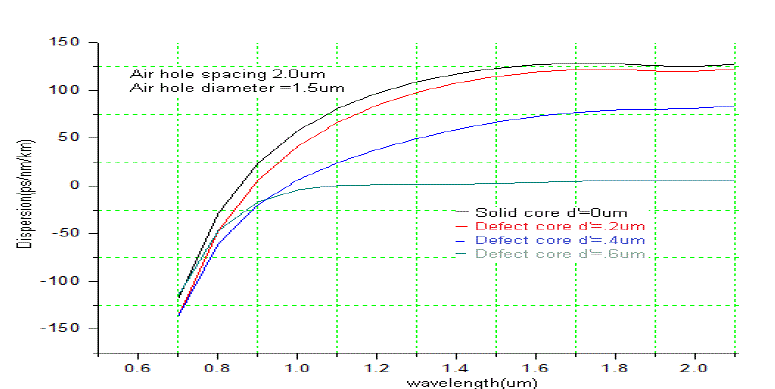 |
| Figure 1 |
Figure 2 |
Figure 3 |
Figure 4 |
Figure 5 |
|
| |
References
|
- Jingyuan Wang, Chun Jiang, Weisheng Hu, MingyiGao, ”Properties of index-guided PCF with air-core”Optics& Laser Technology 39 (2007) 317–321.
- M.JalalUddin and M.ShahAlam,”Dispersion and confinement Loss of photonic crystal fiber” Asian J. Inform, Technol, 7(8):344-349, 2008, ISSN: 1682-3915.
- J.Laegsgaard,K.P.Hansen,M.D.Nielsen,T.P.Hansen,J.Riishede,K.Hougaard,T.Sorensen,
T.T.Larsen,N.A.Mortensen,J.Broeng,J.B.Jensen and A. Bjarklev ”Photonic crystal fibers” 0-7803-7824-5/03/2003 IEEE.
- Jingyuan Wang, Chun Jiang, Weisheng Hu, MingyiGao,” Modified design of photonic crystal fibers with flattened dispersion” Optics & Laser Technology, Vol. 38,PP 169–172,2006.
- M. Pourmahyabadi and Sh. Mohammad Nejad,” Numerical Analysis of Index-Guiding Photonic Crystal Fibers with Low Confinement Loss and Ultra-Flattened Dispersion by FDFD Method” Iranian Journal of Electrical & Electronic E 170 ngineering, Vol. 5,PP170-179,2009.
|